Unlock the Secrets of National Park Camping
As the sun rises over the vast expanse of America's national parks, the sound of chirping birds and rustling leaves fills the air, beckoning outdoor enthusiasts to embark on an unforgettable adventure. National park camping is a unique experience that allows you to immerse yourself in breathtaking natural beauty, away from the hustle and bustle of city life. However, the popularity of these parks can make it challenging to secure a campsite, especially during peak seasons or holidays. In this article, we will unlock the secrets of national park camping, providing you with insider tips and valuable information to plan your next epic outdoor adventure.
National Park Camping 101
Before diving into the nitty-gritty of national park camping, it's essential to understand the basics. National parks offer various types of campsites, ranging from backcountry sites to developed campgrounds with amenities like flush toilets and showers. Some parks also offer group campsites, RV sites, and even luxury glamping options. To ensure a smooth camping experience, it's crucial to research the park's camping regulations, including any specific rules or restrictions.

When planning your trip, consider the time of year and the park's climate. Some parks are best visited during the spring or fall, while others are more suitable for summer or winter camping. Be sure to check the park's website for up-to-date information on weather conditions, trail closures, and any other important alerts.
Choosing the Right Campsite
With over 1,000 campgrounds across the country, selecting the perfect campsite can be overwhelming. To make the process easier, consider the following factors: proximity to amenities, scenic views, and accessibility. If you're looking for a more secluded experience, opt for a backcountry site or a developed campground with fewer amenities.
Some popular national parks, like Yellowstone and Yosemite, offer online reservation systems, making it easier to book a campsite. However, these systems often fill up quickly, especially during peak seasons. To increase your chances of securing a spot, consider using a service like YesYouCamp, which provides campsite availability notifications.
Insider Tips for National Park Camping
Experienced campers know that timing is everything when it comes to national park camping. To avoid the crowds and secure a campsite, consider visiting during the off-season or arriving early in the morning to snag a first-come, first-served spot. Additionally, be prepared to adapt to changing weather conditions and park regulations.

When it comes to gear, pack smart and bring only the essentials. National parks often have limited cell phone reception, so be sure to bring a map, compass, and a portable charger. Don't forget to bring bear spray, as some parks require it, especially in areas with high bear activity.
Campsite Amenities and Activities
While national park camping is all about immersing yourself in nature, many campsites offer amenities to enhance your experience. Some parks offer shower facilities, potable water, and flush toilets, while others may have picnic tables, grills, and fire pits.
When it comes to activities, the possibilities are endless. From hiking and biking to fishing and wildlife watching, national parks offer a wide range of outdoor pursuits. Be sure to check with park rangers or visitor centers for information on guided tours, ranger programs, and any other events or activities.

Practical Applications and Real-World Examples
So, how do you put these insider tips and practical applications into action? Let's take Yellowstone National Park as an example. With over 2,000 campsites, Yellowstone can be overwhelming, especially during peak season. By using a service like YesYouCamp, you can receive notifications when a campsite becomes available, increasing your chances of securing a spot.
Another example is Yosemite National Park, which offers a range of camping options, from backcountry sites to developed campgrounds. By researching the park's camping regulations and using a service like YesYouCamp, you can plan a successful camping trip, even during peak season.

Future Developments and Implications
As national park camping continues to grow in popularity, it's essential to consider the impact on the environment and wildlife. By adopting sustainable camping practices, such as using eco-friendly gear and respecting wildlife habitats, we can help preserve these natural wonders for future generations.
In addition, advancements in technology, such as campsite reservation systems and availability notifications, are making it easier for campers to plan and secure their dream camping trips. As these technologies continue to evolve, we can expect to see even more innovative solutions for national park camping.

Conclusion
National park camping is an unforgettable experience that allows you to immerse yourself in breathtaking natural beauty. By understanding the basics, choosing the right campsite, and using insider tips and practical applications, you can plan a successful and enjoyable camping trip. Whether you're a seasoned camper or just starting out, national park camping has something to offer everyone.
Don't let sold-out campsites hold you back from experiencing the beauty of America's national parks. With services like YesYouCamp, you can receive notifications when a campsite becomes available, increasing your chances of securing a spot. Learn more about YesYouCamp and start planning your dream camping trip today: https://www.yesyoucamp.com
